The History of Fingerprinting & the Study of Dermatoglyphics!

& the Study of Dermatoglyphics
The history of fingerprinting started long ago. In quite a few ancient cultures fingerprints have been used as an item of decoration. And fingerprints are known to have been used as signatures as early as the second millenium BCE. But it took about 3 millenia since then before a fingerprint was confirmed as a suitable tool for identification in the Western world.
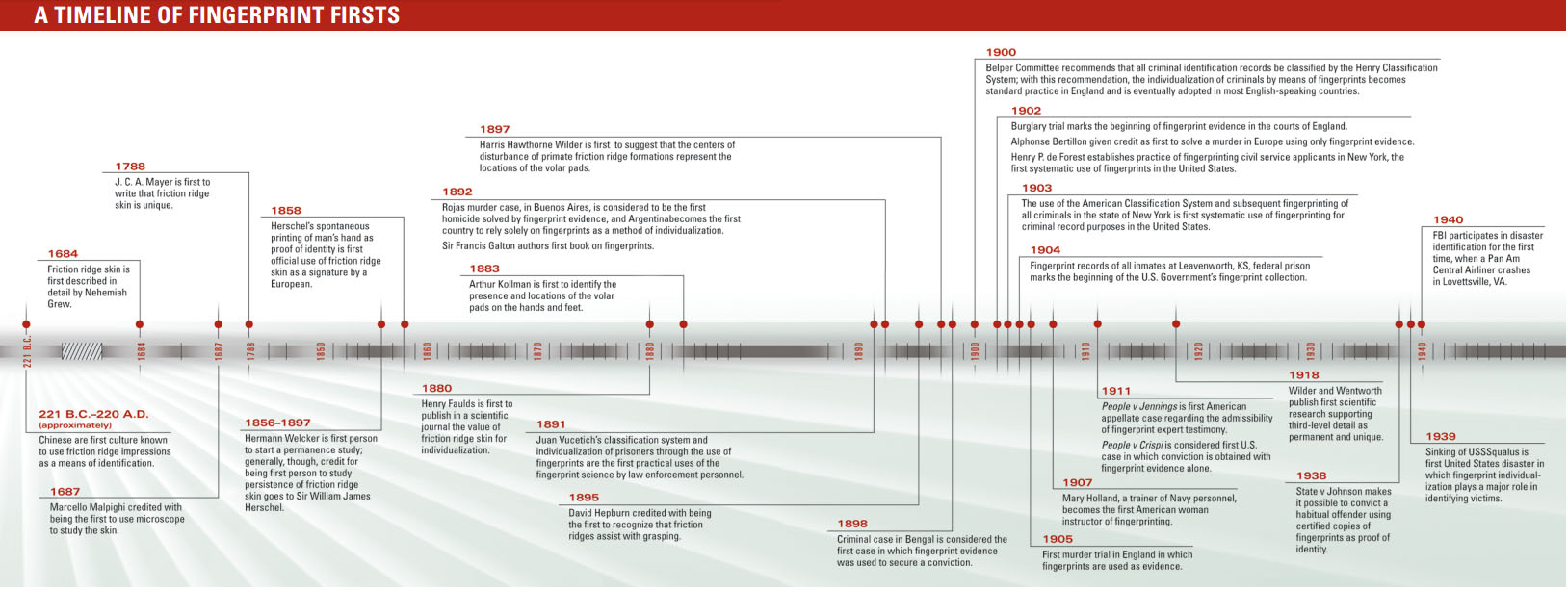
Beyond the fingerprint first reported in the picture above, these are some of the most important milestones:
» (1) The oldest known fingerprint impressions: earthenware estimated to be 6000 years old was discovered at an archaeological site in northwest China and found to bear clearly discernible friction ridge impressions.
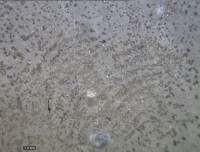 These prints are considered the oldest friction ridge skin impressions found to date. Fingerprints have also been found on ancient Babylonian clay tablets, seals, and pottery.
They have also been found on the walls of Egyptian tombs and on Greek and Chinese pottery, as well as on bricks and tiles in Babylon and Rome.
These prints are considered the oldest friction ridge skin impressions found to date. Fingerprints have also been found on ancient Babylonian clay tablets, seals, and pottery.
They have also been found on the walls of Egyptian tombs and on Greek and Chinese pottery, as well as on bricks and tiles in Babylon and Rome.
» (2) Use of fingerprints for identification: almost 4 millenia ago fingerprints were already used as substitutes for signatures. Around 1900 BC fingerprints were used in Babylon in order to protect against forgery and falsification - parties to a legal contract impressed their fingerprints into the clay tablet on which the contract had been written. References from the era of the Babylonian king Hammurabi (1792-1750 BC) indicate that law officials fingerprinted people who had been arrested. By 246 BC, Chinese officials impressed their fingerprints in clay seals, which were used to seal documents. With the advent of silk and paper in China, parties to a legal contract impressed their handprints on the document, and in China around 300 AD handprints were used as evidence in a trial for theft. In 650 AD, the Chinese historian Kia Kung-Yen remarked that fingerprints could be used as a means of authentication (in Persian: Gavaahi-e Sanad).
 Later friction ridge skin impressions were also used as proof of a person's identity in China perhaps as early as 300 B.C.; other countries followd much later, e.g in Japan as early as A.D. 702, in the 14th century Persia, various official government papers had fingerprints impressions, and fingerprints have been used for identification in the United States since 1902.
Later friction ridge skin impressions were also used as proof of a person's identity in China perhaps as early as 300 B.C.; other countries followd much later, e.g in Japan as early as A.D. 702, in the 14th century Persia, various official government papers had fingerprints impressions, and fingerprints have been used for identification in the United States since 1902.
» (3) First attempts to map fingerprint pattern types: in 1686 a professor of anatomy named Marcello Malpighi at the University of Bologna in Italy, notes the common characteristics of spirals, loops and ridges in fingerprints, using the newly invented microscope for his studies. In time, a 1.88mm thick layer of skin, the "Malpighi layer," was named after him.
 Although Malpighi was likely the first to document types of fingerprints, the value of fingerprints as identification tools was never mentioned in his writings.
Later, in 1823 a thesis was published by Johannes Evengelista Purkinje, professor of anatomy with the University of Breslau, Prussia, which describes details for nine different fingerprint patterns (see pictures below). Still, like Malpighi, no mention is made of fingerprints as an individual identification method.
Although Malpighi was likely the first to document types of fingerprints, the value of fingerprints as identification tools was never mentioned in his writings.
Later, in 1823 a thesis was published by Johannes Evengelista Purkinje, professor of anatomy with the University of Breslau, Prussia, which describes details for nine different fingerprint patterns (see pictures below). Still, like Malpighi, no mention is made of fingerprints as an individual identification method.
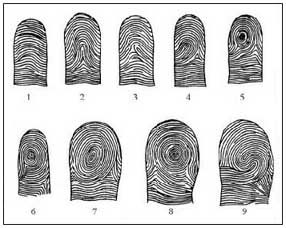
» (4) Uniqueness of every fingerprint discovery:
 although friction ridge skin had been studied for a
number of years, it would be 1788 before the uniqueness of fingerprints was recognized in Europe. It was J. C. A.
Mayer, a German doctor and anatomist, who was the first to write that friction ridge skin is unique. Mayer wrote, "Although the arrangement of
skin ridges is never duplicated in two persons, nevertheless the similarities are closer among some individuals.
In others the differences are marked, yet in spite of their peculiarities of arrangement all have a certain likeness" (Cummins and Midlo, 1943, pp 12-13).
although friction ridge skin had been studied for a
number of years, it would be 1788 before the uniqueness of fingerprints was recognized in Europe. It was J. C. A.
Mayer, a German doctor and anatomist, who was the first to write that friction ridge skin is unique. Mayer wrote, "Although the arrangement of
skin ridges is never duplicated in two persons, nevertheless the similarities are closer among some individuals.
In others the differences are marked, yet in spite of their peculiarities of arrangement all have a certain likeness" (Cummins and Midlo, 1943, pp 12-13).
» (5) Discovery of correlations between fingerprints & volar pads: in 1883 Arthur Kollman of Hamburg, Germany, became the first to identify the presence and locations of the volar pads on the hands and feet; his paper 'The Tactile Apparatus of the Hand of the Human Races and Apes in Its Development and Structure', added to the research being conducted on friction ridge skin. Kollmann studied the embryological development of friction ridge skin, proposing that ridges are formed by lateral pressure between nascent ridges and that ridges are discernible in the fourth month of fetal life and are fully formed in the sixth month.
In the year 1887 Blaschko noticed the relationship between the dermatoglyphics and the 'volar pads' already - an important issue to understand the hand development. And later, Harris Hawthorne Wilder, Professor of Zoology at Smith College who published his first paper in 1897, became the first to suggest that the centers of disturbance of primate friction ridge formations actually represented the locations of the volar pads; he also developed the hypothesis of a relationship between primate friction ridge patterns and volar pads. Much later, Kristine Bonnvie described in a 1924 paper titled 'Studies on papillary patterns of human fingers' this relationship much more convincing.
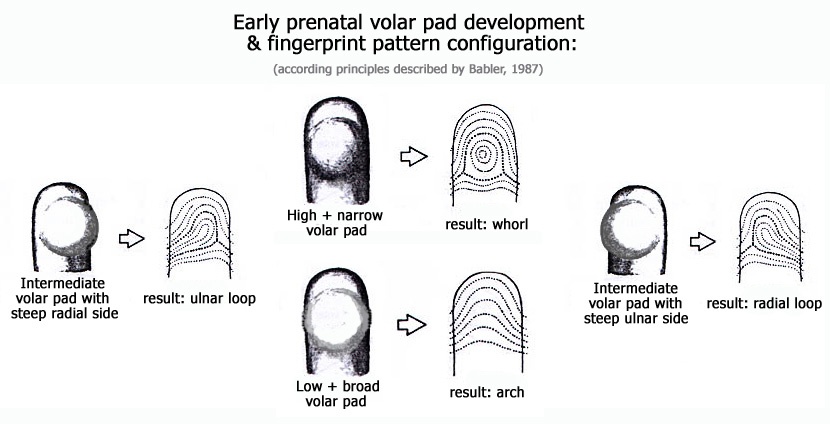
» (6) Discovery of relationship between fingerprints & disease: It was Dr. Harold Cummins (1893-1976) of Tulane University in New Orleans, LA, who described first that volar pad regression takes place almost concurrently with the beginning of friction ridge development; that the size, location, growth, and configuration of the volar pad affects the friction ridge patterns; Cummins also described that disease or birth defects have an effect on the growth of volar pads and as consequence also on fingerprint configuration. Cummins also introduced the term 'dermatoglyphics' (dermatoglyphs), and his book 'Fingerprints, Palms, and Soles - An Introduction to Dermatoglyphics' (published in 1943 with his coauthor Charles Midlo) is still recognized to represent a landmark in the history science of fingerprints. However, it took quite a while before the significance of his work was fully recognized;
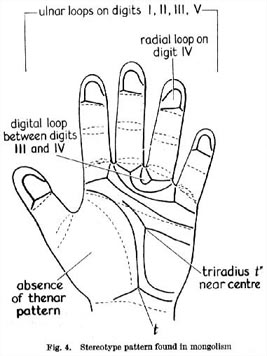 because the importance of Cummins observations became much more apparent after the discovery of the genetic cause of Down's syndrome - about 20 years after Cummins major discovery!
because the importance of Cummins observations became much more apparent after the discovery of the genetic cause of Down's syndrome - about 20 years after Cummins major discovery!Some of the palmar stereotypes of Down's syndrome are shown in the 'phantom-picture' that was published by L.S. Penrose in 1963 in the well-known scientific magazine 'Nature'; Penrose's phantom picture (see picture) became a role-model for the use of combining fingerprints, palmar dermatoglyphics & the major flexion creases as a diagnostic tool in the perspective of medical science.
NOTICE: 'Phantom pictures' for many other syndromes & diseases are presented in a brand new section (available since the 2nd half of 2015):
Recommendation for further reading about the history of fingerprints: The Fingerprint Sourcebook
How to classify a fingerprint? ...more.
![]() FINGERPRINTS INDEX:
FINGERPRINTS INDEX:
INTRO: Fingerprint Distributions & Hand Diagnostics
• HISTORY of Fingerprints
• CLASSIFICATION of Fingerprints
• SEXE DIFFERENCES & Fingerprints
• ETHNIC DIFFERENCES & Fingerprints
• DISEASES & Fingerprints
• Fingerprints & BEHAVIOR!
• FINGERPRINT DISTRIBUTIONS on the 5 Fingers
• WORLD MAP of Fingerprints
• 10 Facts about radial loop fingerprints
• 10 Facts about arch fingerprints
• MORE NEWS about Fingerprints (+ Palm Dermatoglyphics)
• Dermatoglyphics Multiple Intelligence Test {Review]
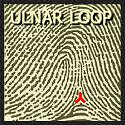
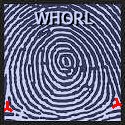
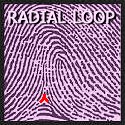
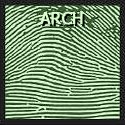
ULNAR LOOP - WHORL - RADIAL LOOP - ARCH
![]() FINGERPRINT DIAGNOSTICS:
FINGERPRINT DIAGNOSTICS:
• Fingerprints in DIABETES MELLITUS!
• Fingerprints in RHEUMATOID ARTHRITIS!
• Fingerprints in SCHIZOPHRENIA!
• Fingerprints in DOWN SYNDROME!
• Fingerprints in FRAGILE-X SYNDROME!
_(In autism 2% to 6% have Fragile-X syndrome!)
Video: the history of fingerprinting
• The hand lines (palmar creases)
• The simian line
• The Sydney line
• The Hypothenar whorl
• What can finger length reveal?
• The 5th finger (pinky)
• The fingernail tutor

EARLY HAND DIAGNOSTICS:
& HANDS ON HEALTH CARE!!
Always be aware: even though fingerprints bare the potential to show significant clues for aspects of personality, diseases & syndromes, multiple perspectives of the hand need to be taken in consideration in order to make a well substantiated reliable assessment or diagnosis.
The no.1 rule in Multi-Perspective Hand Reading describes the fundamental major principle where scientific hand reading begins: